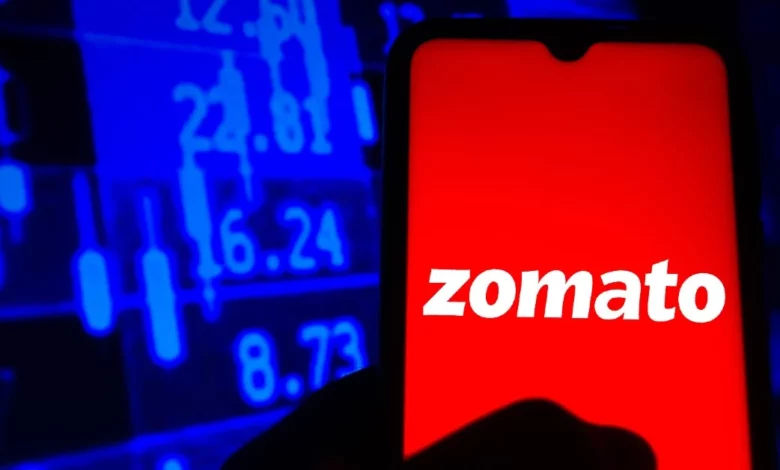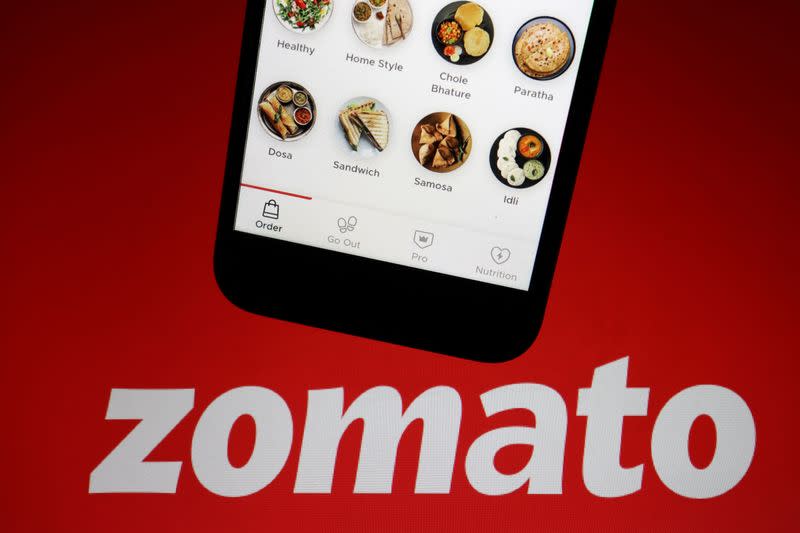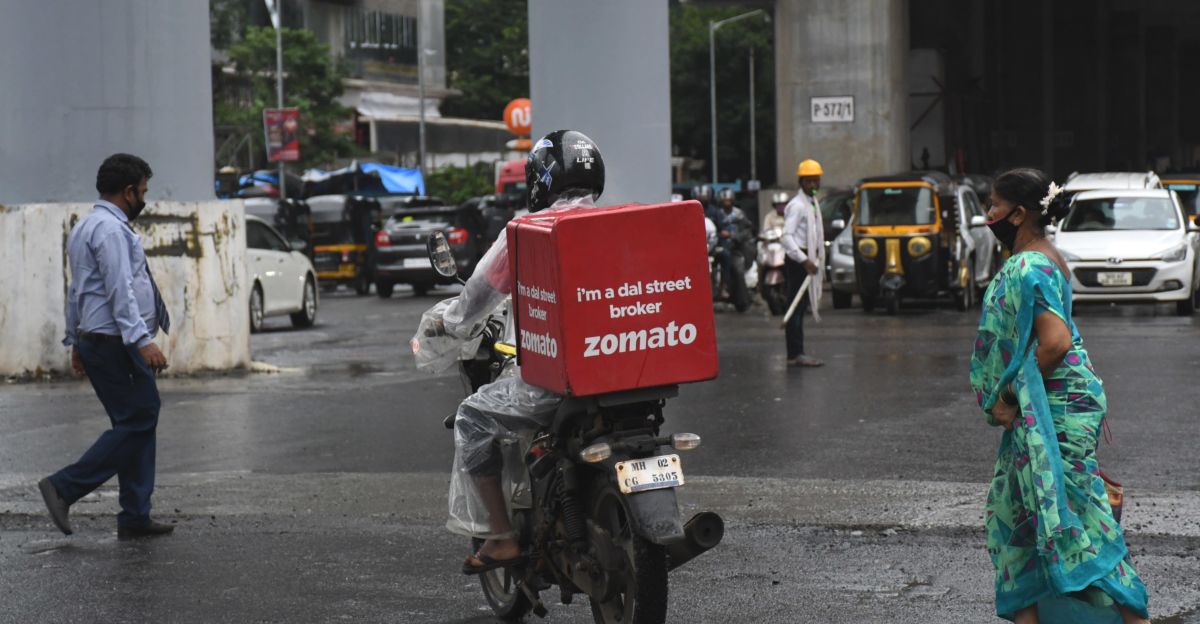Why has the price of Zomato’s shares dropped to its lowest level ever and it’s Share Value sees a decrease of 14.3% as the lock-in period expires.

Records for Zomato Share Value A decrease of 14.3% as the lock-in period expires.
Zomato had a fantastic start on July 23, 2021, in the Mumbai market, but since then, the value of its shares has fallen by more than 60%.
Following a 2021 listing, a one-year lock-in period for promoters, staff, and other investors ended, causing the meal delivery app Zomato’s shares to drop sharply by 14.3% on Monday. The period during which investments cannot be sold or redeemed is known as the lock-in period.
The shares of the listed company traded at Rs. 47.45, down 11.6% from the prior closing on Monday at 11:11 am, according to a report from the news agency ANI.
The company had a fantastic start on July 23, 2021, in the Mumbai market, but since then, the value of its shares has fallen by more than 60%.
When discussing the subject, Punit Patna, an equity research analyst at Swastika Investment, said, “Since being listed, Zomato Ltd. has significantly underperformed and has seen a staggering 71% price decline from its all-time high. Following the start of the rate hiking cycle by central banks around the world and the significant sell-off in the tech sector, the company has been ignored by investors.”
Because of this, he continued, “we are against Zomato Ltd., notwithstanding its dominant position among online platforms for food delivery and the recent correction.”
The Board of Directors of food aggregator company Zomato recently approved a plan to buy cash-strapped fast commerce firm Blinkit for Rs 4,447 crore. According to Blinkit, formerly known as Grofers, the acquisition will increase Zomato’s hyperlocal delivery fleet utilization and lower delivery costs.
In the past year, several other companies, including Zomato, experienced significant increases on their exchange debuts but eventually underperformed and fell sharply from their all-time highs.
Analysts contend that these businesses lacked organized focus and direction, while others blamed the downturn on an excessive valuation.
Why has the price of Zomato’s shares dropped to its lowest level ever?
The last time the company’s stock suffered such a steep downturn was following its purchase of fast-commerce startup Blinkit (formerly Grofers) last month.
Zomato’s shares hit an all-time low of around Rs 50 on Monday, July 25, after the year-long lock-in period for its pre-IPO concluded on Friday (July 22). The company’s stock price dropped as low as Rs. 46 in the early trading hours, or about 40% below its issue price of Rs. 76.
Why did Zomato’s stock experience such a steep decline?
The mandatory lock-in period for promoters, staff members, and other shareholders who purchased Zomato stock before its IPO concluded on Friday. According to analysts, the leading cause of Monday’s significant sell-off is that these stockholders are now free to sell their shares.
Following Securities and Exchange Board of India (SEBI) regulations, a company’s pre-IPO shares are locked in for a year if there are no identifiable promoters. “Depending on market conditions and their investment horizon, pre-offer shareholders may sell their shares in our company after the one-year lock-in period.
Additionally, any belief by investors that such sales would take place could impact the market price of the equity shares, according to Zomato’s Red Herring Prospectus before its first public offering (IPO).
The company was valued at roughly Rs 43,200 crore as a private company, but its market cap at the time this article was published was just Rs 37,911 crore. At its previous peak, the company’s stock was trading at Rs 169.10 per share, with a market capitalization of Rs 1.33 lakh crore. As of publication, more than Rs 95,000 crore in investor wealth had been lost.
The last time the company’s stock suffered such a steep downturn was following its purchase of fast-commerce startup Blinkit (formerly Grofers) last month. Zomato’s shares had fallen by more than 20% during the subsequent four sessions.
How are the stocks of other startups doing?
In July of last year, Zomato became the first significant startup to list on the stock exchanges. The company’s shares, recorded for Rs. 116 a share, a premium of 53% over the IPO price of Rs. 76, saw a record-breaking opening. The stock’s value, though, has steadily decreased ever since it peaked in November of last year at Rs 169.10 per share.
Since going public, the stock values of other firms that followed Zomato to the exchanges have also experienced a sharp decline. Paytm, which had an initial public offering price of Rs 2,150, was down more than 65% at the time of publication and trading at Rs 740.35.
As its shares were up 78% when it initially floated, e-commerce firm Nykaa, which had an issue price of Rs 1,125 per share, experienced a brisk listing. The share’s price has now dropped, with its scrip selling at Rs 1,410.35 at the time of publication.
With the pre-IPO investor lock-in expiration, Zomato’s shares will likely be sold in tranches.
According to sources speaking with Moneycontrol, buyer interest in Zomato shares is muted, and new investors may be willing to purchase them at a discount to the stock’s current market value.
As the one-year lock-in period for pre-IPO investors draws to an end, the food delivery behemoth Zomato, one of the first unicorns to list last year, is under selling pressure on the stock exchanges. According to sources from Moneycontrol, investment bankers have been compiling a book for block deals and shares worth Rs 1,000 crore are instantly up for sale.
According to sources who spoke with Moneycontrol, buyer demand is muted, and new investors may be willing to purchase Zomato shares at a discount to the current market price.
According to sources, multiple sellers exist, and the sale of shares may occur in phases.
According to a source, shareholders deemed insiders due to their significant stock holdings and board positions are prohibited from selling until 48 hours following the release of the quarterly results. Therefore, huge investors may sell later following regulations.
Zomato went public a year ago for Rs 76 a share, and it currently trades for between Rs 50 and Rs 55 per share.
According to a source with firsthand information, low buyer interest and the possibility of supply pressure on share price “may have precluded a significant exodus at the conclusion of lock-in.”
How can one tell if Zomato will descend even further? As explained by Karan Taurani

We may likely observe unit economics shifting lower, which could be monitorable unless something goes wrong there due to delivery costs inching up, wage inflation, and gasoline expenses. Karan Taurani, Senior VP at Elara Securities, said, “I think they are working very hard to enhance their take rates from the restaurant partners because that is a very high trigger to drive unit economics.
The lock-in period for investors who purchased Zomato pre-IPO shares was lifted on July 23. Therefore, we were forced to witness this particular anomaly, but if Zomato has coverage, at what point does it become a buy, given that it is under $50?
Zomato has always worried that when the lock-in period expires, many PE investors who would have purchased this stock at shallow values will sell off their holdings.
If you look at them, pre-IPO firm valuations were close to $4.5–$5 billion. When they reached their height, they were valued at roughly $8–8.5 billion in the IPO and about $11–12 billion when they went public. Investors who purchased shares at valuations of $3–4 dollars would have expected to make some profit after the lock-in period was lifted, which has indeed occurred.
Because the multiple comparisons with the global peers and the discounts had converged in contrast to when they announced it roughly three months ago, the values are currently at their lowest point, and there is no overhang in the traditional sense.
They are currently trading at close to four times EV sales or about 3.5–4 times EV sales, and when compared to some of its competitors, such as Jubilant NSE -1.33 per cent in the QSR business, they would be at a minor premium. Therefore, values today are more reasonable than they were at the time of listing when they had reached a peak of close to 16–17 times EV sales. That was outrageous, and the justification for using those value multiples at the time was also different.
There was a feeling that they would likely achieve superior unit economics in terms of profitability at the time. Many opportunities were developing in the fragmented rapid commerce market, and if they entered it, there might be further losses. Additionally, over the past 1.5 years, we have witnessed pressure from the NRAI and CCI to restrict take rates effectively. These are some of the worries raised about the stock that has been under pressure.
I believe there are two things we could keep an eye on. One is if unit economics starts to decline at this point. Contribution margins for the food industry were approximately 4.5 per cent at the height of the epidemic; today, these margins range from 1.5 to 1.7 per cent, an improvement over the previous two quarters.
Therefore, unless something goes wrong due to increasing delivery costs, wage inflation, and fuel expenses, we may likely observe a decline in unit economics, which could be observable. Since that is a powerful trigger to push unit economics, I believe they are trying very hard to boost their take rates from the restaurant partners.
Most of the other levers have been closed. Therefore, whether you refer to it as the order value or delivery fees, the growth rate is no higher than 3 to 4 per cent. Take rates are one area that will significantly impact overall unit economics, so it’s essential to keep an eye on how it develops.
The stock’s third key indicator would be the fast commerce sector’s potential decline. That market segment is seeing rapid expansion, and in the next three to five years, the possible market size will increase by a factor of three to four compared to the present. Although there are opportunities of that nature, they are somewhat scattered and over-discounted.
There are a lot of big players seated there. What type of cash burn are we anticipating due to that segment? These three monitorable will determine whether the stock can continue to decline or is likely to hold at current levels.
As Zomato Stock Price Drops to Record Low, Twitter Memes Increase

Zomato’s market value has dropped from 1.29 lakh crore at its all-time high in November to 36,600 crores ($4.58 billion) today.
New Delhi: On Monday, the one-year share lock-in period for promoters, workers, and other investors ended, causing Zomato, the Indian food delivery company, to see a more than 14% decline in share price to a record low.
Zomato’s valuation has decreased by more than 60% after its great stock market debut on July 23 last year.
When the markets closed today, the price of Zomato stock was 46.80, but Zomato was trending heavily on Twitter thanks to memes, so the drop did not occur there.
The stock experienced its most significant intraday decline on Monday since January 24. The company’s market value has dropped from 1.29 lakh crore at its all-time high in November to 36,600 crores ($4.58 billion).
A proposal to acquire the rapid commerce business Blinkit was recently accepted by Zomato’s Board of Directors. However, rumours claim that the investors are at ease with the acquisition of Blinkit.






